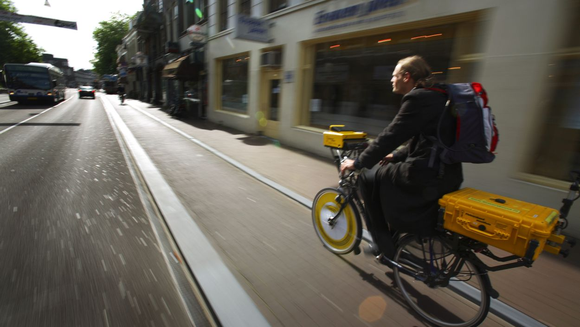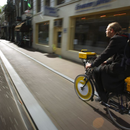The Data Collection Bicycle is a bicycle equipped with sensors to detect location, sound, vibration and air quality. These variables are measured to assess the cycling comfort that is experienced while riding a normal bicycle. The Data Collection Bicycle was used by the Dutch Cyclists Union (Fietsersbond) to be able to evaluate and compare the cycling infrastructure in various cities in the Netherlands (Fietsbalans programme). The Data Collection Bicycle measures GPS-position, speed, vibration level, sound level and particulate matter. The bicycle was developed by M+P, an expert consultancy company in the field of noise, vibration and air quality.
The Data Collection Bicycle was one of the first bicycles to measure cyclist comfort and the concept was copied by parties in other European countries.
Main technologies used
- Class 1 sound level meter
- Vibration transducers on steer and saddle position
- CPC and DustTrak air quality measurement instruments
- GPS receiver for position and speed, augmented with wheel rotation sensor
- Video camera to record visual environment
- Tailor-made data collection and processing software running on a portable computer
How does the system collect/generate data (if any): The bicycle measures the vibration level, sound level and air particle count at a one second interval and stores these together
with speed and position in an internal database. The data collected during a measurement ride where the cyclist is instructed to cycle as a normal commuter. After the ride, the data is transferred and further analysed.
How does the system use data (if any): Based on the measurement data of several rides, a cycling comfort map can be generated. This uses the sound and vibration data to derive a comfort score. The score depends on the road surface texture and sound levels. Averaging the scores produces a general score for the cycling climate in a city.
Lessons learnt / factor of success (technical, legal, organisational, financial, geographic, …): When the Data Collection Bicycle was developed, there were quite a lot of technical challenges. However, the technology has advanced since then so these technical challenges are currently much smaller.
Because there are less technical challenges, everybody can now produce a bicycle with microphones and accelerometers. But measuring is only half of the story. For the success of assessing cycling comfort, it is important to have a good model that relates measurement values to comfort. You need to gain experience with the measurement method to be able to
finetune the model and get relevant results.
Thirdly, to improve the cycling comfort, one needs to know what to do on the cycling infrastructure to improve the comfort score. For instance, what can a road builder do on the cycle
path surface to reduce the vibrations while maintaining safety and durability. This means that involvement of road manufacturers is necessary in the process of improving the cycling climate in a city.
Web link(s):





